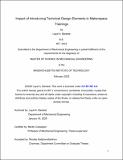Impact of Introducing Technical Design Elements in Makerspace Trainings
Author(s)
Barakat, Layal A.
DownloadThesis PDF (5.031Mb)
Advisor
Culpepper, Martin
Terms of use
Metadata
Show full item recordAbstract
Makerspaces are used as a tool in higher education to support curricular, hands-on projects and encourage student extracurricular and personal projects. Because access to making is more self-driven, there is a gap between what makerspace trainings teach students and what students are expected to know by the time they reach capstone courses in engineering. To test the effects of introducing a technical makerspace training to students, several steps were taken. First, known barriers to making were explored and organized into categories. Second, Design Expertise was defined as a means to combat these barriers: it is a combination of (1) knowledge, (2) skill, (3) perspective, and (4) motivation. Third, a rigorous framework, the Design-Fabrication-Performance (DFP) matrix was created to break down design expertise into manageable chunks. Next, existing makerspace trainings at MIT were characterized using the DFP matrix. Afterwards, the DFP matrix was used to design a new, experimental training which would incorporate engineering design thinking and expertise with the typical makerspace machine training structure. Finally, 23 student participants were recruited, surveyed using a Likert scale (1 = strongly disagree, 5 = strongly agree), and interviewed to understand the impact of the training on participant perspectives, engineering identity, and maker motivation. Initial results suggest that student self-efficacy increases as a result of the training, This outcome is shown by the highest average differential of all survey responses (M = 0.78, SD = 0.85) for question 15: “I am confident in my ability to use GIR level knowledge to design and make things that perform as intended”. The maker training reinforced the motivation to make things for a majority of students, with the average score for the associated question being 4.48 (SD: 0.85). The training also positively impacted some traditionally marginalized groups in STEM. For the statement "I feel comfortable in engineering at MIT", women averaged 3.27 and men 3.90 before the training. The average differentials in the post- and pretraining scores to this question for these groups were 0.4 and 0.91 respectively. The training also appears to level playing field for students with less advanced backgrounds in engineering and science. For the question “I am confident in my ability to solve GIR level problems on my own”, students with parents with graduate degrees or higher averaged 4.44 before the training, while those with parents with undergraduate degrees or lower averaged 3.57. The average differentials are 0.22 and 0.64 respectively. Although students saw the value in modeling systems before design and fabrication, several questions demonstrated that students found modeling to be tedious and preferred to test and iterate on their designs in the makerspace; further work is needed to eliminate barriers to sustain student interest and participation in the long term. A longitudinal study following these students would also be needed to reveal long term outcomes such as STEM retention and long-term makerspace usage.
Date issued
2025-02Department
Massachusetts Institute of Technology. Department of Mechanical EngineeringPublisher
Massachusetts Institute of Technology